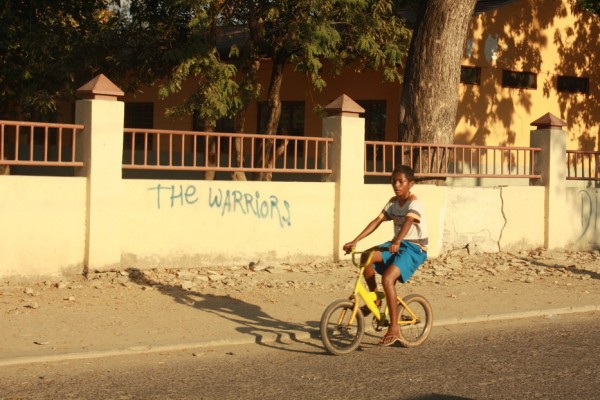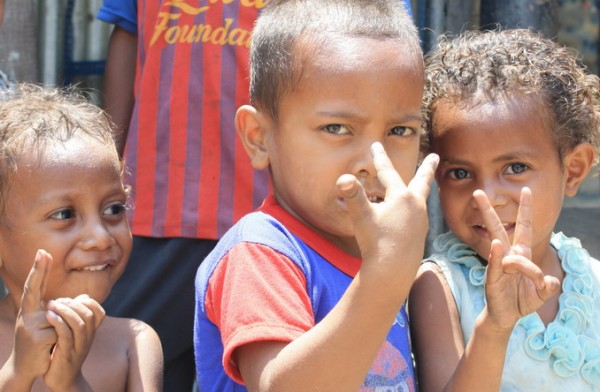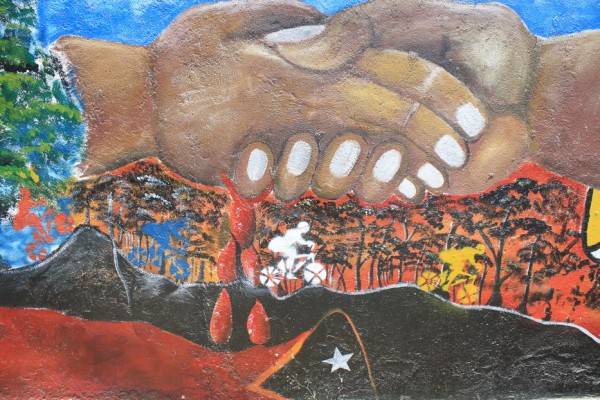A SMALL BAND of dust-covered children emerge from their house of corrugated tin into the sunlight and call, “Photo please! Photo please!” They’ve seen my camera slung around my neck — since early morning I’ve been walking the streets of Dili taking photos, so I’m happy to oblige.

Dispatch From Timor-Leste on the 10th Anniversary of Independence
The older boy, about six, raises his toy semi-automatic rifle in mock seriousness and aims it at me, playing the universally loved war game of boys around the world. Except here it’s a little alarming, especially since the weapon looks real. Here, war is far from a game.
I reach out and gently push the nose of the rifle away from me.
“Be careful,” I tell him in Indonesian. “Guns are dangerous.”
He giggles and reverts to being a child again. The rifle lowers to the ground. He understands Indonesian, though the native language of Timor-Leste is Tetum. Then I ask slyly, disarming him with the familiar family reference of adik, “Little brother, where are your underpants?”
The children burst into giggles. The boy grins down at his state of nakedness.
“I don’t like underpants,” he replies proudly.
The little girl beside him has caramel skin and curly hair touched by the sun. Her dress is sky blue and trimmed in ruffles, but her arms and legs are covered with dust and her feet are bare. When she smiles, it seems a smile without a care in the world, though what her family must have endured I can only guess.
In Timor-Leste, Southeast Asia’s youngest and poorest country, anyone over 12-years-old would have been alive when the Indonesian military went on a murderous rampage, destroying entire villages and killing thousands of people after 78% voted for independence in 1999.
The people of East Timor, as it was then known, had already fought for almost 25 years to be free of Indonesian military occupation. In 1975, days after the Portuguese withdrew from over 400 years of colonial rule, Indonesia invaded with brute force, killing five Australian journalists, among the only outside witnesses to the attack.
Within six months 60,000 people, or 10% of the population, had been killed by an elite military force armed and trained by the US military, despite the condemnation of the United Nations. A young Jose Ramos-Horta, East Timor’s newly appointed foreign minister who would later win the Nobel Peace Prize, had traveled to New York to appeal to the UN for assistance and thought the resolution would affirm his people’s right to self-determination. Yet in the next three years his sister was killed by a Bronco aircraft and two brothers by an M-16 and Bell helicopter assault.
As the struggle continued, more than 250,000 people died — about a third of the country’s population of 800,000 — in what was, per capita, the worst holocaust of the 20th century. Xanana Gusmão, who, like Ramos-Horta, would one day be president of a free Timor-Leste, led the Fretilin resistance movement then. In his journal he wrote: “Every ridge, every stone, every brook and tree had witnessed such tremendous suffering…We could feel the voices of the dead…”

“I wish to remind all those who are not yet grey-haired that we come from a very peaceful society, an understanding society — in spite of our history of long struggles for independence that instilled a fighting character in our society — a society of warriors, but also a society capable of uniting itself at a specific moment of its history.” ~ Former resistance fighter and president Xanana Gusmão
As the atrocities escalated, the world media remained silent. East Timor, which fought to protect Australia from Japanese invasion during the Second World War, was left to fight alone. Numerous leaked documents reveal that the US, Australian, and British intelligence gave Indonesia “the green light” through non-action, arms deals, media censorship, and a freshly inked series of business contracts with oil and mining companies to exploit East Timor’s offshore oil and natural gas.
November 12, 1991, marked a turning point when the gunning down of hundreds of peaceful demonstrators in Santa Cruz cemetery was caught on film, opening the eyes of the world to the atrocities that had occurred in East Timor. Under international pressure, Indonesia’s president Habibie, successor to the deposed dictator Suharto, opened the path for the referendum in 1998. Yet even with the majority vote in favor of independence, freedom came at a tremendous price, with Indonesian troops killing thousands in their withdrawal.
Against these odds, a nation was born on May 20, 2002, and since then Timor-Leste (East Timor in the Tetum language) has undertaken the long and difficult task of nation building under the watchful eyes of UN peacekeepers.
Last year marked the 10th anniversary of Timor-Leste’s independence. I’ve come to learn about this fledgling country, about what the people have suffered, and how far they’ve come on their journey towards recovery. Wary of strangers, people can be shy and circumspect, but if I smile and say hello they’re quick to return the greeting.
Some appear deeply troubled, like the woman of about 35 squatting beneath a banyan tree on the shore, a lime green bandana in her hair, gazing out to sea. I follow her gaze where fishing boats float placidly at anchor along a pristine shoreline shaded by banyans and framed by mountains covered in gold, sundried grass.
It’s hard for me to imagine that thousands of people were shot or killed with machetes here, their bodies tossed in the water. On the cliff tops, where the road winds from Dili to Kupang on the Indonesian side of West Timor, monuments to the dead are carved from stone and painted with the face of the Virgin Mary.
The woman remains under the banyan for a long time. I want to take a photo of her but decide against it. There are times a camera is needed as a witness, and others when it should be put away out of respect for privacy.
It helps knowing Indonesian so I can chat a little. I buy most of my drinks and snacks from the sellers on the road. The scruffy-haired daughter of the water-cart woman holds her hand out, wagging her head and exclaiming something in Tetum, already like a streetwise old woman. Her mother glowers when I hand her the money for a bottle of Aqua. If I had her life I wouldn’t be feeling too friendly either, seeing yet another foreigner with an expensive camera, powerless to help her.

According to the Asian Development Bank, more than half of Timor-Leste’s population is 18 years or younger, with over 60% of children from the poorest families going to school. The challenge now is to provide educational opportunities for the remaining 40%, like these children.
UN land cruisers the size of small yachts sail by. Coils of razor wire top the gated compounds of the Chinese, South Korean, and Irish embassies like crowns of thorns. A dog lies sleeping on the street, balls splayed on the pavement. Graffiti is everywhere. Two little boys play in a ditch, making a game of scooping out the mucky water with an old cup.
Timor-Leste is among the world’s 20 least developed countries, with basic income, health, and literacy levels similar to those of sub-Saharan Africa, with which it shares special diplomatic relations as a recovering postcolonial and post-conflict nation. Unemployment or underemployment runs as high as 70%, and despite reports from the Asian Development Bank of Timor-Leste being “an exciting frontier economy,” it still depends largely on international donors. According to the CIA and US State Department, “major exports are oil and natural gas to Australia, the US, and Japan.”
While money continues to be poured into building roads, power stations, and other elements of infrastructure, some Timorese are still struggling internally to reconcile their original vision of peace with the difficult reality of daily life and a lingering military mindset, similar to that of the boy I met on the street.
A local bookstore prominently displays Karl Marx, Malcom X Untuk Pemula (“Malcom X for Beginners”), a biography of John Lennon, and The Mute’s Soliloquy by Indonesia’s foremost postcolonial writer, Pramoedya Ananta Toer, who, like Xanana Gusmão, suffered years in prison in his fight for human rights.
Despite the hardships, what’s so striking is the readiness of the Timorese to forgive and move forward. People remain strong in their faith (86% are Roman Catholic), and churches are among the many buildings being rebuilt. On the waterfront, the home of Bishop Belo, who shared the Nobel Peace Prize with Ramos-Horta in 1996, is open to the general public and often full of visitors. In the garden, a Timorese man with his son smiles at me and strikes up a conversation. “Thank you for visiting my country,” he says.
The land border between East and West Timor can be crossed by citizens of both countries, bumping back and forth on buses through similar mountainous countryside of rice fields, mushroom-domed thatch houses, and bougainvillea blossoms fire-bright against the dunny landscape. At no time has my husband, who is Indonesian, felt unsafe here — while the island of Timor may be politically divided since colonial times, the people on both sides are essentially the same.
Over 50% of Timorese speak Indonesian, and many families are blended, like the woman I meet at the Indonesian embassy who’s married to an Indonesian and seeks to rejoin him in Kupang. One man wearing a Timor-Leste jacket bearing the yellow, red, and black of the flag, is going to study at university in Indonesia. “I must go where I have opportunities,” he says. “But I will come back. This is my home.”
The resilience of the Timorese people is also evident in the leadership of Ramos-Horta and Gusmão, who promote open dialogue rather than violent confrontation between opposing sides, a reconciliation process similar to that of a North American First Nations healing circle. Over subsequent years, both served as leaders of Timor-Leste, followed by a new president in 2012, Taur Matan Ruak, a respected former Falintil field commander, in a peaceful election.

One of many wall murals that brighten the city. The Timor-Leste flag acknowledges the country’s past with the use of color: Yellow denotes its history of colonization by Portugal; black, the darkness that must be overcome; red, the blood shed in the struggle for liberation; the white star, peace and a guiding light to the people.
One of the most hopeful signs of Timor-Leste’s recovery is the country’s participation in sports. Dili now hosts two international events: the Dili Marathon of Peace held every June, and the annual Tour de Timor bicycle race in September, bringing positive international attention and a burgeoning tourism industry.
In preparation for these events, as well as for their own fitness, Timorese are lacing on their trainers, donning sports gear bearing the new Timor-Leste flag, and hitting the streets. Children are in on the action, too — throughout Dili and the surrounding countryside, they can be seen playing football in schoolyards, riding bikes, and jogging in matching tracksuits.
Along Dili’s waterfront promenade, stretching from the 27-metre Rio de Janeiro-style statue of Jesus on the point and along the busy harbor, joggers and cyclists pass families playing in newly constructed playgrounds and parks near the presidential palace. Back near the old banyan tree where the woman sat earlier, an athlete trains at the water’s edge, practicing his boxing moves. A girl stops jogging to wade in the ocean and stretch as she looks at the sunset.
I watch some kids race, laughing across the sand, and I can’t help but think of the boy I met this morning, covering his poverty with his pride. A boy still on the fragile edge. Will he have the opportunity to have a bike, a track suit, or trainers? When he grows up what will he be?
As I walk back to my room at East Timor Backpackers in the gathering darkness, a young girl in a yellow sundress smiles and says hello as she rides by on her bike. The sign outside a brightly lit street-front classroom advertises computer, accounting, and English classes. Inside, students work diligently on old computers, creating new lives for themselves. There shall be no more suffering alone in silence — the doors to the world are wide open.
Read and watch more
- Timor Lives!, by Xanana Gusmão. A series of speeches by the poet, former resistance fighter, and president of Timor-Leste.
- A Dirty Little War, by John Matrinkus, one of the few journalists to reveal what really happened in the time of East Timor’s vote for independence.
- Distant Voices, by John Pilger. One of the world’s foremost journalists covering human rights abuses, Pilger traveled to East Timor in 1993 and secretly filmed a documentary on the atrocities committed there in Death of a Nation: The Timor Conspiracy.
- A New Generation Draws the Line: Humanitarian Intervention and the “Responsibility to Protect” Today, by Noam Chomsky, about the “new interventionism” of Western powers in newly independent countries such as Timor-Leste.
- The Frost Interview: Jose Ramos-Horta: Lessons in Patience